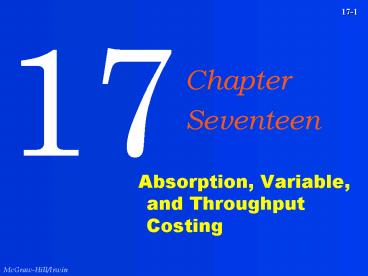Absorption, Variable, and Throughput Costing - PowerPoint PPT Presentation
1 / 41
Title:
Absorption, Variable, and Throughput Costing
Description:
Chapter Seventeen Absorption, Variable, and Throughput Costing Absorption Costing A system of accounting for costs in which both fixed and variable production costs ... – PowerPoint PPT presentation
Number of Views:861
Avg rating:3.0/5.0
Title: Absorption, Variable, and Throughput Costing
1
17
Chapter Seventeen
- Absorption, Variable, and Throughput Costing
2
Absorption Costing
- A system of accounting for costs in which both
fixed and variable production costs are
considered product costs.
Fixed Costs
Variable Costs
3
Variable Costing
- A system of cost accounting that only assigns the
variable cost of production to products.
Fixed Costs
Product
Variable Costs
4
Absorption and Variable Costing
5
Absorption and Variable Costing
The difference between absorption and variable
costing is the treatment of fixed manufacturing
overhead.
6
Absorption and Variable Costing
Lets put some numbers to an example and see what
we can learn about the difference between
absorption and variable costing.
7
Absorption and Variable Costing
- Mellon Co. produces a single product with the
following information available
8
Absorption and Variable Costing
- Unit product cost is determined as follows
Selling and administrative expenses are always
treated as period expenses and deducted from
revenue.
9
Absorption Costing Income Statements
- Mellon Co. had no beginning inventory, produced
25,000 units and sold 20,000 units this year at
30 each.
10
Absorption Costing Income Statements
- Mellon Co. had no beginning inventory, produced
25,000 units and sold 20,000 units this year at
30 each.
11
Absorption Costing Income Statements
- Mellon Co. had no beginning inventory, produced
25,000 units and sold 20,000 units this year at
30 each.
12
Variable Costing Income Statements
- Now lets look at variable costing by Mellon Co.
13
Variable Costing Income Statements
- Now lets look at variable costing by Mellon Co.
We exclude the fixed manufacturing overhead.
14
Variable Costing Income Statements
- Now lets look at variable costing by Mellon Co.
15
Comparing Absorption andVariable Costing
- Lets compare the methods.
16
Comparing Absorption andVariable Costing
- Lets compare the methods.
17
Comparing Absorption andVariable Costing
- Lets compare the methods.
18
Reconciling Income Under Absorption and Variable
Costing
- We can reconcile the difference between
absorption and variable net income as follows
Fixed mfg. overhead 150,000 Units
produced 25,000
6.00 per unit
19
Extending the Example
Lets look at the second year of operations for
Mellon Company.
20
Mellon Co. Year 2
- In its second year of operations, Mellon Co.
started with an inventory of 5,000 units,
produced 25,000 units and sold 30,000 units at
30 each.
21
Mellon Co. Year 2
- Unit product cost is determined as follows
There has been no change in Mellons cost
structure.
22
Mellon Co. Year 2
Now lets look at Mellons income
statement assuming absorption costing is used.
23
Mellon Co. Year 2
Units in ending inventory from the previous
period.
24
Mellon Co. Year 2
25,000 units produced in the current period.
25
Mellon Co. Year 2
Next, well look at Mellons income
statement assuming variable costing is used.
26
Mellon Co. Year 2
27
Mellon Co. Year 2
Excludes fixed manufacturing overhead.
28
Summary
In the first period, production (25,000
units) was greater than sales (20,000).
In the second period, production (25,000
units) was less than sales (30,000).
29
Summary
For the two-year period, total absorption income
and total variable income are the same.
30
Summary
- Lets see if we can get an overview of what we
have done.
31
Summary Comparison of Absorption (AC) and
Variable Costing (VC)
This was the case in the first period when
production of 25,000 units was greater than sales
of 20,000 units.
Inventory increased from zero to 5,000 units and
120,000 absorption income was greater than
90,000 variable income.
32
Summary Comparison of Absorption (AC) and
Variable Costing (VC)
In the second period sales of 30,000 units were
greater than production of 25,000.
33
Summary Comparison of Absorption (AC) and
Variable Costing (VC)
Inventory decreased from 5,000 units to zero, and
230,000 absorption income was less than
260,000 variable income.
34
Summary Comparison of Absorption (AC) and
Variable Costing (VC)
For the two-year period, units produced equals
units sold, so total absorption income equals
total variable income.
35
Cost-Volume-Profit Analysis
- CVP includes all fixed costs to compute
breakeven. - Variable costing and CVP are consistent as both
treat fixed costs as a lump sum. - Absorption costing defers fixed costs into
inventory. - Absorption costing is inconsistent with CVP
because absorption costing treats fixed costs on
a per unit basis.
36
Evaluation of Variable Costing
Management finds it easy to understand.
Consistent with CVP analysis.
Emphasizes contribution in short-run pricing
decisions.
Advantages
Profit for period not affected by changes in
fixed mfg. overhead.
Impact of fixed costs on profits emphasized.
37
Evaluation of Absorption Costing
Advantages
38
Impact of JIT Inventory Methods
In a JIT inventory system . . .
Production tends to equal sales . . .
So, the difference between variable
and absorption income tends to disappear.
39
Throughput Costing
Unit-levelspending fordirect costs.
Productcost
Unit-level costs are incurred every time a unit
ofproduct is manufactured and will not be
incurredagain until the next unit is
manufactured.
40
Throughput Costing
ExampleIn an automated process direct material
may bethe only unit-level cost and so is the
only product cost. All other manufacturing
costs are expensed as period costs.
Incentive to overproduceis reduced
Average unit cost doesnot vary with changesin
production levels.
41
End of Chapter 17































